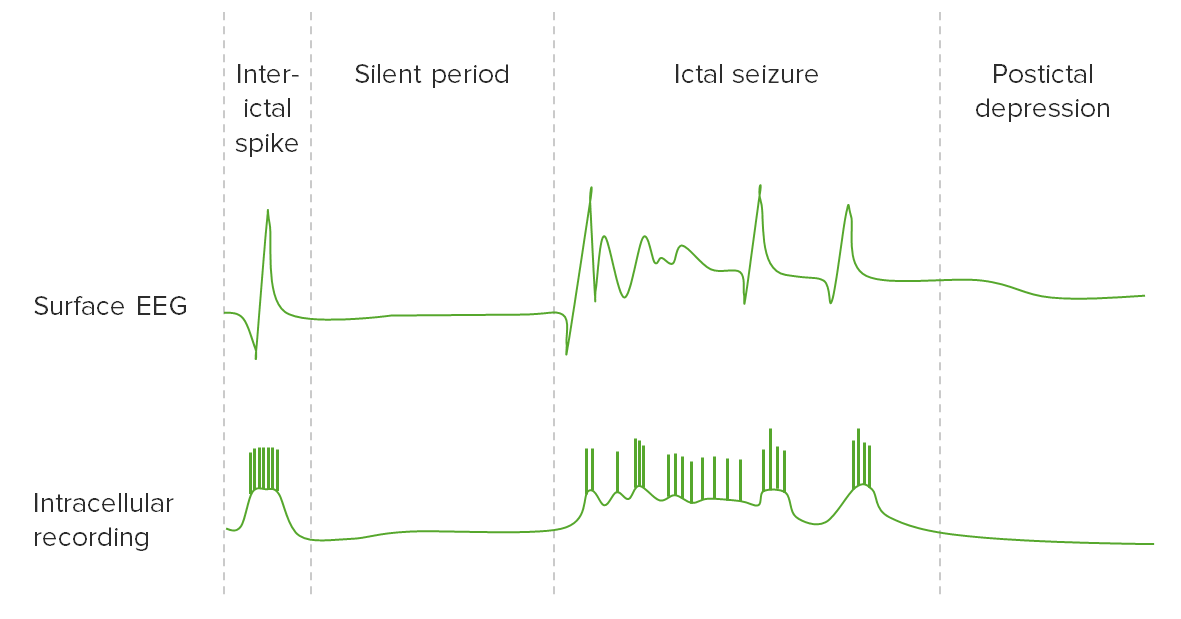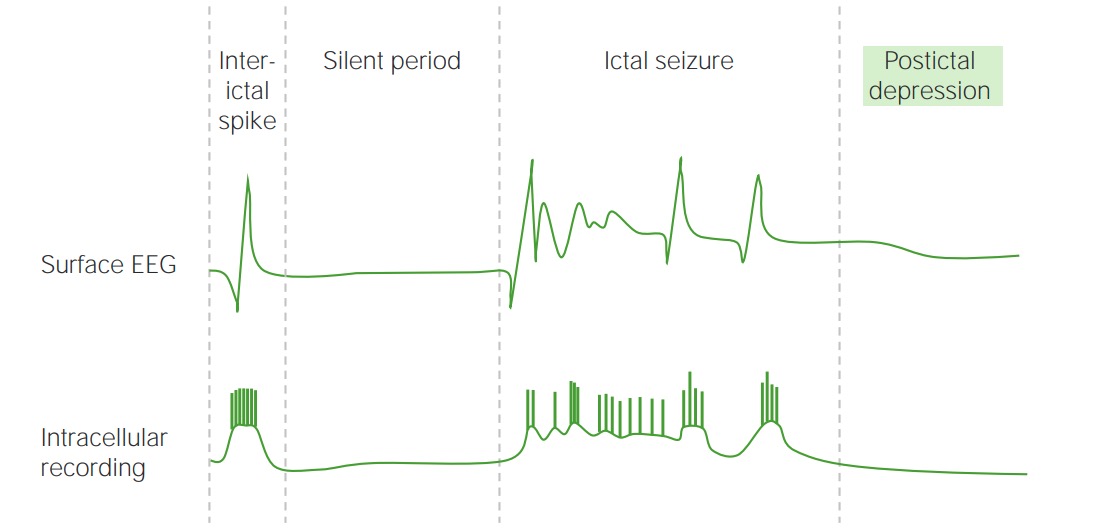Playlist
Show Playlist
Hide Playlist
Status Epilepticus: Emergency Treatment, Initial Investigation and Long-term Treatment
-
Slides Seizures Epilepsy Status Epilepticus.pdf
-
Download Lecture Overview
00:01 How about the treatment for status epilepticus? Let's walk through what we do emergently. 00:06 And with our initial investigations and long-term treatment to stop this continuous seizure activity. 00:12 We'll start with the first five minutes. 00:14 This is the stabilization phase, and we do the ABCs. 00:17 We focus on airway, breathing, circulation, and any disability or neurologic exam abnormalities. 00:24 We need to make sure the patient has an open airway, That airway is clear of blood or sputum production or those things. 00:31 We focus on breathing and often provide oxygen supplementation, and don't tend to have circulatory arrest unless there's another potential cause of the status. 00:40 But those ABCs are important for any patient who's presenting with a life threatening emergency. 00:47 The second piece is to look at the time. 00:49 And time the seizure from its onset and monitor vital signs rigorously during that first few minutes of the seizure. 00:56 The first three minutes feel like three hours. 00:59 Though most seizures 90% to 95% of seizures will resolve spontaneously within the first three minutes. 01:06 We assess oxygenation. 01:08 Give oxygen via nasal canula, facemask, and may consider intubation if there is respiratory dysfunction or concern for respiratory arrest, or assistance is needed. 01:18 we initiate EKG or ECG monitoring for all these patients, either by EMS in the field, or in route, in an ambulance, or in the emergency department. 01:27 And then we typically think about collecting some early tests that can help to intervene for patients who may have an exacerbation that's causing this continuous seizure activity. 01:37 Hypoglycemia, even hyperglycemia can cause seizures, and so we collect a fingerstick, blood glucose, and intervene. 01:44 The intervention is different for children by age and in adults, we think about both D50. 01:49 To to rescue hypoglycemia, as well as intravenous thiamine. 01:55 And then the last step during the stabilization phase is to attempt IV access, collect electrolytes for blood testing, hematology, or toxicology screening. 02:06 And if appropriate, check anticonvulsant levels for patients who may be on anti-epileptic medicines and have a diagnosis of epilepsy. 02:14 So that stabilization phase is critical. 02:16 We think about it in the first zero to five minutes, but maybe in the first zero to two, or three minutes for patients who suffer a new onset of seizure in a hospital setting. 02:27 If the seizure does continue, we consider the initial therapy phase if the seizure does not continue, then the patient proceeds to symptomatic medical management and care. 02:37 During this initial therapy phase, there are a number of interventions that are done to stop the seizure from occurring. 02:44 Benzodiazepines are the initial therapy of choice for aborting a seizure, and for stopping status epilepticus. 02:52 We typically choose one of several agents including intramuscular midazepam, intravenous lorazepam, and intravenous diazepam. 03:02 These are equivalent medicines and sometimes it depends on the availability of those. 03:06 We want to get them started and get them started quickly to abort that seizure. 03:11 If none of these agents are available, we can consider intravenous phenobarb, as well as rectal diazepam, or intranasal midazolam. 03:19 And I mentioned those because that can be used by patients or caregivers at home. 03:23 In a chronic epileptic who has breakthrough seizures, and we really want to prevent multiple recurrent seizures. 03:28 Rectal administration of diazepam, or intranasal midazolam can be performed at home. 03:35 If the seizure continues, we repeat the intravenous, intramuscular, intranasal benzodiazepine up to three times spaced out about every three to five minutes. 03:46 If the seizure continues, we move into the second line therapy phase. 03:50 If the seizure does not continue, and abates after abortion with the benzodiazepine, we work on symptomatic medical management. 03:58 And in many of those patients, we continue on to second line therapy to stop the seizure from recurring after it has initially been aborted. 04:10 During the second line therapy phase, we think about a number of medicines, anti-epileptics, and we'll talk about three that are used to stop the seizure. 04:18 These are anticonvulsant medications. 04:21 And we tend to think of one of three medicines. 04:24 Intravenous fosphenytoin, intravenous valproic acid and intravenous levetiracetam. 04:31 These are important medicines to remember. 04:33 These are the definitive treatments for status epilepticus. 04:37 And their doses are sometimes tested. 04:39 And are things we need to know in this emergent setting to manage these patients. 04:43 Fosphenytoin is given at a dose of 20 mg per kg. 04:47 Valproic acid is given an a dose of 40 mg per kg, and levetiracetam has given it a dose of 60 mg per kg. 04:54 And we'll talk about those a little later in the lecture as well. 04:57 If none of these are available, we can consider intravenous phenobarbital. 05:01 Historically, this was the medicine used as the first choice for status epilepticus. 05:05 But it has been replaced by these newer agents. 05:09 So again, then we reevaluate the patient after administration of that agent. 05:13 And if the seizure continues, we move into the third phase of treatment, and if not, we move to symptomatic management of the patient, at that time. 05:21 There's no clear evidence or guide about what to do in this third phase of treatment. 05:26 This is for seizures that continue after that initial definitive treatment. 05:31 Typically, we would consider a second line therapy. 05:34 So a fosphenytoin was selected, initially. 05:36 We'd move to valproic acid, or levetiracetam. 05:39 If levetiracetam was administered initially, we'd moved to fosphenytoin or valproic acid. 05:45 And that's the initial management of status epilepticus.
About the Lecture
The lecture Status Epilepticus: Emergency Treatment, Initial Investigation and Long-term Treatment by Roy Strowd, MD is from the course Seizures and Epilepsy.
Included Quiz Questions
What is the first step when treating a patient with status epilepticus?
- Assess airway, breathing, and circulation
- Fingerstick for blood glucose
- Initiating an ECG
- Make a note of the time
- Administer medication
What action should be performed during the second stage of treatment for status epilepticus (SE) (5–20 minutes)?
- Administer IV lorazepam if the seizure continues.
- Medications should be administered even if the seizure has resolved.
- Administer IV phenobarbital if the seizure continues.
- Administer rectal diazepam if the seizure continues.
- Administer intranasal midazolam if the seizure continues.
Which option is considered a definitive treatment for status epilepticus (SE)?
- 20 mg/kg IV fosphenytoin
- 50 mg/kg IV phenobarbital
- 100 mg/kg IV levetiracetam
- 10 mg/kg IV valproate
- 0.5 mg/kg intranasal midazolam
Customer reviews
5,0 of 5 stars
| 5 Stars |
|
5 |
| 4 Stars |
|
0 |
| 3 Stars |
|
0 |
| 2 Stars |
|
0 |
| 1 Star |
|
0 |





